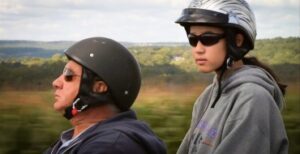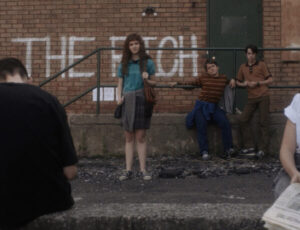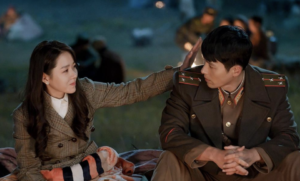Suddenly my dreams are flooded with colour and adorable animated kitties and tree-squirrels and other unspecified cute n’ fuzzy creatures who talk to me in Japanese, and little girls who kick serious evil butt! Okay, so maybe as a feminist and long time Buffy-fan, the latter is not that unusual for me to dream about, but the others, especially all of the above in combination can only be attributed to one thing in my waking life: the Studio Ghibli marathon I’ve embarked on recently courtesy of the Cinematheque! This marathon is not to be taken lightly, this is some serious movie watching business, I’ve been running, sprinting, biking, swimming with Ponyo, sword fighting with Nausicaä, flying on Kiki’s broomstick, and exploring world after world of beautiful, extraordinary anime.
It is the ‘return’ of Studio Ghibli at The Cinematheque, but I am discovering many of the Ghibli classics for the first time and acquainting myself with a handful of strong, spirited, daring, and independent female characters whom I now adore. It’s making me wish I had grown up watching Ghibli princesses like Nausicaä and Mononoke rather than Disney’s Snow White and Cinderella, but alas, the magical, fantastical productions of Studio Ghibli were not part of my childhood. I was quite late to hop on the Ghibli train, and I didn’t discover my first Studio Ghibli feature until just three years ago, at age 19.
My first impression of Studio Ghibli was through Disney’s English adaptation of Ponyo on the Cliff (2008) which I have since heard actually falls short of many Studio Ghibli Fans’ favourite lists, most likely due to its unusual ‘outside’ influence. Like many other Studio Ghibli productions, Ponyo was written and directed by Hayao Miyazaki. However, the storyline was inspired by the Hans Christen Anderson story “The Little Mermaid”. For some viewers this acts as a deterrent, but for me it was the hook that pulled me into to the world of Ghibli.
I grew up on Disney, and The Little Mermaid was one of my favourites, along with Snow White, Cinderella, Sleeping Beauty, Beauty and the Beast, and other gems that taught me if I just shut up and looked pretty a handsome prince might come and save me! So, when I discovered Ponyo I was thrilled at the retelling of one of my childhood ‘classics’ but with Ponyo instead of Arielle: an adorable fish and quirky child rather than a hyper-feminine, hyper-sexualized adolescent mermaid who has no problem giving up her voice for a set of human legs. Studio Ghibli is known for, (and often praised for) having brave, strong and un-Disney-like heroines, so as far as Ponyo goes, she may not be as feisty or as dominant as princess Naussicaa, or as brave as Chihiro from Spirited Away (2001), or as strong and independent as Kiki from Kiki’s Delivery Service (1989), but Ponyo definitely has a voice! She is not afraid to speak her mind, and she does not give up her voice for anyone (or anything).
Since I was initially drawn to Studio Ghibli because of a girl who could talk, discovering all of the ass-kicking, sword-wielding Ghibli girls who can save themselves and/or save others too, has been a really exciting and satisfying journey. Because of my recent Studio Ghibli marathon and The Return of Studio Ghibli at The Cinematheque, I now have two new favourite Ghibli characters, Kiki, and Nausicaä! Honestly, Nausicaä is the only princess I would ever want to be, or want my future daughter, (or son, or child period.) to want to be. She is smart, strong, inquisitive, fearless, and basically an environmental activist and human and animal rights advocate that saves the world! Technically, Nausicaä is not really a Studio Ghibli character, but she is the character that started it all. From Nausicaä of the Valley of the Wind (1984), princess Nausicaä, born from manga created by Miyazaki, captured the hearts of little girls and boys across Japan and soon after, the hearts of children and adults across the globe. It was largely due to this vast success of Nausicaä of the Valley of the Wind that Studio Ghibli formed the following year, in June 1985.
After watching and experiencing more of the colourful art and magic that is Studio Ghibli, I have decided, it is not just the awesome Ghibli girls that have me coming back for more. I have discovered a couple other reoccurring themes and subtexts that excite and fascinate me, and ultimately make me want to invest in my own complete Studio Ghibli collection so that I may be able to watch and re-watch and share them with my future children, nieces, and nephews. All of the Studio Ghibli films I have watched thus far hold some really positive and realistic messages. I would be lying if I said there aren’t some reoccurring stereotypes and comedic tropes that bug me, but for the most part Studio Ghibli films break down stereotypes and blur binaries by painting a spectrum of gender and morality. The line between masculinity and femininity is blurred because so many Ghibli characters contain multiple traditionally ‘feminine’ and ‘masculine’ qualities regardless of their own gender. Visually, many of the Ghibli characters are quite androgynous.
All of Studio Ghibli’s main characters have strengths and weaknesses, charms, and flaws. The line between good and evil is often erased because many of the antagonists are given likable qualities too. We are made to empathize with lots of the ‘bad’ guys, and we are shown what it is that drives them. Most of the Ghibli villains are multi-dimensional and have some ‘good’ and some ‘humanity’ in them that the audience can relate to. Take for instance, Dola from Castle in the Sky (1986). When we are first introduced to Dola, she appears to be nothing but selfish, greedy, and gluttonous, but as the film progresses we see her in moments of kindness, we are shown that she is also nurturing, practical and assertive. When Dola overhears young protagonists Sheeta and Pazu talking fondly of her, she is surprised and touched by their sentiment. In turn we are touched by this self-reflexive moment and by Dola’s own dismay to their liking of her. In Princess Mononoke (1997) Lady Eboshi is another complex and interesting antagonist. Many of her workers, such as all of the ex-brothel girls, see her as a wondrous and fearless leader, and through them, we can see this side of her too. Lady Eboshi rescued them from work they did not enjoy, and she created jobs and a sense of purpose for all of the people in her village. However, one of her main faults is that she does not care about nature, not the plants or the animals, or any of the spirits of the forest which she plans to destroy.
This brings me to the other reoccurring Studio Ghibli theme that I have discovered during my Studio Ghibli marathon. There are always underlying messages of environmental justice. Again and again in the productions of Studio Ghilbi it is person or people vs. nature, with a protagonist who strives to save the trees, the forest, the jungle, the animals, and the land. Studio Ghibli breathes life into nature, giving trees and plants and wild animals personalities and voices that are so enchanting and endearing, we cannot help but walk away from the screen wanting to save the plants and animals of our own world too! Or at the very least, these films start a conversation, open up a dialogue with all ages of Ghibli viewers about what it means to find a balance and live in harmony with nature.









